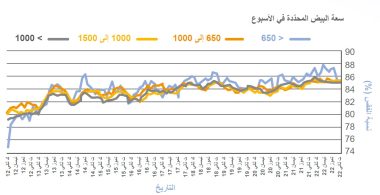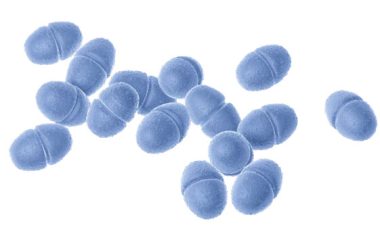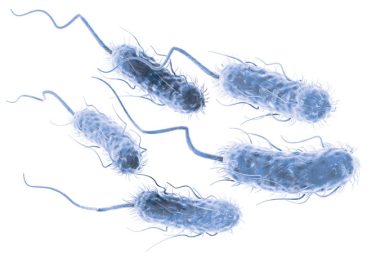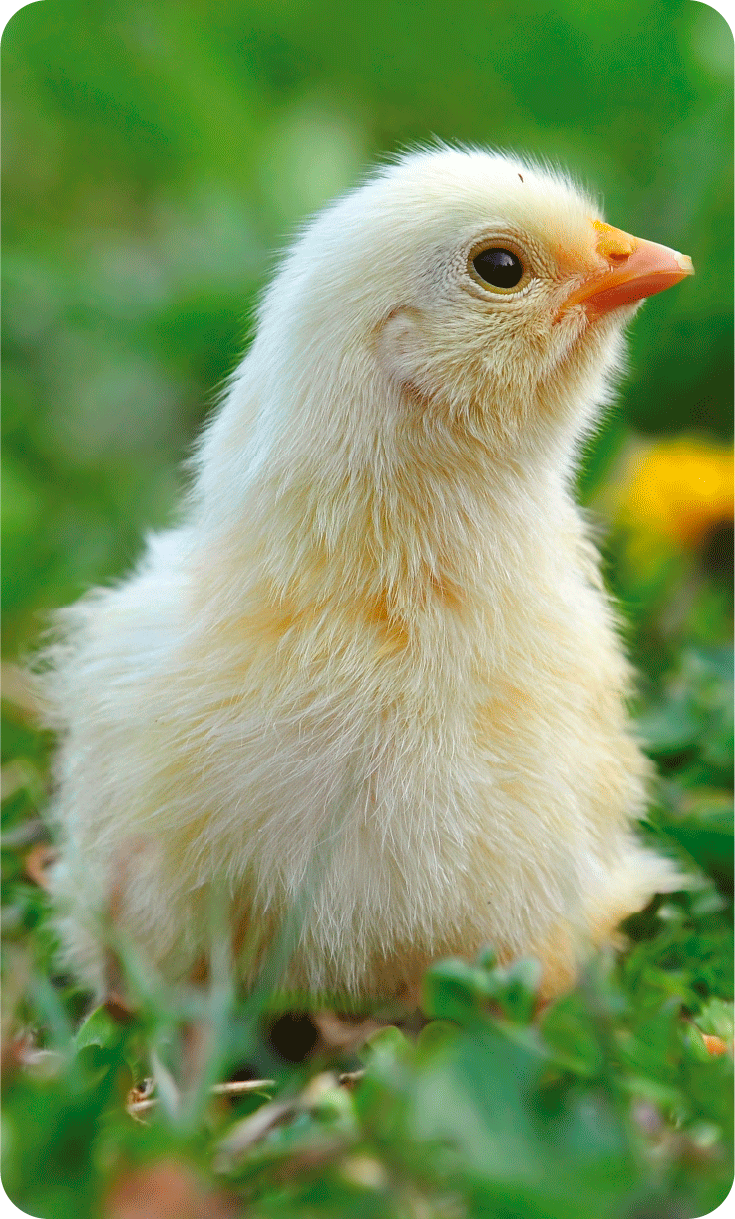تراجع معدّل نسبة فقس دجاج التسمين في الولايات المتّحدة في العقد الماضي.

الرسم 1. معدّل فقس دجاج التسمين في الولايات المتّحدة بين عامي 2012 و 2022 بالنسبة لسعة البيض في المفقس المحدّدة بين 650,000 و مليون بيضة في الأسبوع. المصدر: AgriStats (فورت واين، ولاية إنديانا، الولايات المتّحدة الأميركيّة).
يبيّن الرسم 1 بيانات من AgriStats(فورت واين، ولاية إنديانا، الولايات المتّحدة الأميركيّة( وهي أكبر شركة مقارنة مرجعيّة (benchmarking) في الولايات المتّحدة. وتَظهر هذه البيانات تراجع فقس البيض بين عامي 2012 و2022 بالنسبة لسعة البيض المحدّدة لكلّ أسبوع في المفقس.
قد يكون معدّل الفقس حاليّاً قرابة الـ80%، ومنخفضٌ عن المعدّل عام 2012 بنسبة 5%.
تشير بيانات AgriStats إلى انخفاض معدّل فقس بيض دجاج التسمين بنسبة 3% على الأقلّ بين عامي 2020 و2023.
الأسباب المُحتملة لخسائر الفقس
هناك أسباب محتملة عديدة لخسائر الفقس.
- لطالما اعتُبرَت الخصوبة تحدّياً في عدّة قطعان أمّهات، إذ ازداد نفوق الدجاجات وأصبحت جودة قشر البيض مشكلة. تستطيع التغذية وإدارة الإطعام التخفيف من حدّة بعض تلك المشكلات.
ولكن هناك تقارير وأبحاث علميّة قد دلّت حديثاً إلى أنّه من الممكن في أحيانٍ كثيرة تحصيل المكوّرة المعويّة البرازيّة (Enterococcus faecalis)، والمكوّرة المعويّة العوراء (Enterococcus cecorum)، والإشريكيّة القولونيّة (Escherichia coli) من أجنّة ميّتة في بلدانٍ عدّة.
- لكن لم تُوَضّح بعد الأهميّة النسبيّة لكلّ بكتيريا منها.
- بيد أنّ المكوّرة المعويّة البرازيّة مرتبطةٌ أيضاً بنفوق الدجاج عند الأسبوع الأوّل من العمر.
المكوّرة المعويّة البرازيّة (Enterococcus faecalis)
تُعدّ هذه الكائنات الدقيقة شائعة الانتشار في بيئات انتاج الدواجن، كما تتعايش في جهاز الطيور المعوي. تُعتبَر المكوّرة المعويّة البرازيّة جزءاً من مجهريات البقعة المعويّة (gut microbiota) الطبيعيّة لدى الفُريخات السليمة، ولكنّها تستطيع أن تتحوّل إلى كائناتٍ انتهازيّةٍ ممرضةٍ.
أبلغت الدكتورة جودي ديلاغو مؤخّراً عن نتائج المسح الميداني المُجرى في ستّة مفاقس في الولايات المتّحدة الأمريكيّة، وذلك في منتدى الدواجن العلمي العالمي (International Poultry Scientific Forum – IPSF) الذي أقيم في مدينة أتلانتا في ولاية جورجيا الأميركيّة.
- استعملوا 405 بيضة ناتجة عن بقايا فقسٍ، وفيها برهانٌ عن موت الأجنّة المبكر
- ثمّ مسحوا كيس الصفار للحصول على عيّنة مسحٍ معقّمة
- فتمّ بالتالي عزل المكوّرة المعويّة البرازيّة والإشريكيّة القولونيّة ضمن هذا المشروع

تمّ ملاحظة أنّ نسبة وجود عدوى مرافِقَة بنوعَي البكتيريا الآنف ذكرهما أعلى (43%) من نسبة وجود كلّ بكتيريا منها على حدى.
- كانت نسبة وجود المكوّرة المعويّة البرازيّة وحدها 13%، وهي نفس نسبة وجود الإشريكيّة القولونيّة.
- ولكنّ 31% من العيّنات لم تحتوِ على أيّ من البكتيريا الآنف ذكرها.
وقد أوضحت قاريرُ أخرى أنّ المكوّرة المعويّة البرازيّة تستطيع اختراق قشرة البيض والتملّص من حواجز الجهاز المناعي داخل البيض والاستيطان داخليّاً.
تزيد العدوى المرافِقة بنوعَي البكتيريا الآنف ذكرهما من نسبة الإمراض، ما يُسبّب زيادة في نفوق الأجنّة والدجاج حديث الولادة.
تُعتبر المكوّرة المعويّة البرازيّة الأكثر إمراضاً
ولكنّ بعض التقارير تشير إلى أنّ للمكوّرة المعويّة البرازيّة دوراً أبرز في إمراض الأجنّة والفراخ.
وقدّم الدكتور هيوغو راميريز من جامعة ولاية ميسيسيبّي في المنتدى عينه مجموعة حالاتٍ تشخيصيّةً يتراوح تاريخها بين كانون الثاني وتشرين الأوّل من عام 2023. وقد أشارت الحالات التشخيصيّة تلك إلى نسبة تأثير المكوّرة المعويّة البرازيّة على حالات وفاة دجاج التّسمين وفراخ دجاج التّسمين. وقد قدّم الدكتور معلوماتٍ عن حالات وفاة دجاج تسمين يتراوح عمره بين اليوم والسبعة أيام وفراخ أمّهات، بالإضافة إلى 45 حالة من مفاقس مختلفة.
- وقد تمّ التعرّف على البكتيريا في هذه الدراسة باستخدام تقنيّة التفاظ/تأيين الليزر بمساعدة المادة الخلاليّة ضمن مطياف زمن الطيران (المعروفة بـ matrix-assisted laser desorption/ionization time of flight mass spectrometry أو MALDITOF MS).
- تمّ العرّف على النمط الوراثي لأصناف السالمونيلّا عبر تقنيّة الـIntergenic Sequence Ribotyping أو الـISR.

These advanced modern lab analyses provide great credibility to bacteria identification.
The results indicated that Enterococcus spp. was isolated from all evaluated yolk sac samples.
- Enterococcus faecalis was isolated from most of the analyzed samples (n=90; 96.77 %), and only 7 cases corresponded to other
Enterococcus spp. - The association with E. coli was observed in 61.11 % of the cases.
- Salmonella enteritidis was isolated only once.
- In the hatchery samples, Enterococcus faecalis was isolated from 87% of the hatchery cases.
- Only six cases (13 %) were mixed with E. coli and Salmonella spp.
Enterococcus cecorum
Enterococcus cecorum is another gut commensal microorganism that causes considerable broiler industry losses due to sepsis and osteomyelitis.
Effective treatment and control methods like vaccination have been challenging to develop since commensal and pathogenic strains only differ in genomic features, including alterations in capsular polysaccharides.
Mitsu Suyemoto from the College of Veterinar y Medicine at North Carolina State University presented at the IPSF a study where pathogenic Enterococcus cecorum strains were genetically modified for genes that encode capsular biosynthesis (cpsC and cpsO).
- The mutant groups caused lower embryo mortality when eggs were inoculated at 12 days of incubation.
- When chicks were orally gavaged with 107 cfu of pathogenic Enterococcus cecorum strains, the sepsis or presence of bacteria in the spleen at 35 days of age was 55%, and the prevalence of infection in the free thoracic vertebrae (FTV) was 33%.
- In contrast, neither sepsis nor bone infection was observed in the mutant strains.
This study demonstrates that two specific deletions of the bacterium genome eliminate the pathogenicity of E. cecorum. This information could be helpful to understand better the pathogenesis of E. cecorum and the development of control strategies.
Enterococcus cecorum could infect embryos during in ovo vaccination or the hatching period.
James Higuita from the University of Arkansas presented a study demonstrating that embryos can be infected by virulent strains of E. cecorum by in ovo injection into the amnion with 104 cfu/embryo at 19 days of incubation.
When the infected embryos commingled with non-infected embryos, these also became infected.
The infection affected performance as early as seven days post-hatch. The E. cecorum was recovered from all chickens’ guts, spleens, and FTV after day 26. Lesions were also observed as:
- Focal heart necrosis.
- Splenomegaly.
- Hepatomegaly.
- The heart was the organ most affected.
Dr. Marcela Arango from the same research group at Mississippi State University presented another summary of 299 cases received at Mississippi State University’s Poultry Research and Diagnostic Laboratory (PRDL) from January to October 2023.
This study analyzed the distribution of Enterococcus spp. and the pathogenicity of the isolated strains by determining mannitol metabolism or detecting the cpsO gene.
These results indicated the high prevalence of pathogenic E. cecorum in broilers and commensal E. cecorum in breeders. These results confirmed that mannitol metabolism could be a tool to detect E. cecorum pathogenicity.
This study demonstrated how this infection can occur and disseminate and the potential negative impact on broiler growth performance.

- The results indicated that Enterococcus spp. were observed in 127 broiler cases, 85 breeder pullets, 50 hatchery samples, 29 broiler
breeders, 85 commercial layers, and five other cases of poultry samples. - Enterococcus spp. are ubiquitous and present in all poultry categories.
- Nevertheless, E. cecorum accounted for 62% of all Enterococcus spp. isolates from broilers. These were mainly collected from heart and femoral head samples.
- The E. cecorum was identified in 90% of broiler breeder samples from intestines.
- From the broiler isolates, 82% were PCR-positive for the cpsO gene, indicating pathogenicity, while 100% of the breeder isolates recovered from the intestine were cpsO negative, suggesting a commensal status.
- The pathogenic isolates in the majority of cases (96 %) could not metabolize mannitol.
Control of Enterococcus is still a difficult task
- Hatchery biosecurity, cleanliness, and sanitation of the in ovo vaccination systems are critical.
- However, more effective tools to minimize its pathogenicity are needed.
- Direct fed microbials or probiotics could potentially reduce the translocation of E. cecorum into blood circulation, minimizing osteomyelitis and culling.
The in ovo administration of commensal non-pathogenic E. cecorum could also cause competitive exclusion of pathogenic E. cecorum.
Still, dose, frequency, and route of administration require further investigation, as demonstrated by Grayson Walker from NC State University during the IPSF.
Specific bacteriophages have also shown potential to control Enterococcus spp.
- Phages have high specificity and probably must be combined to control the associated pathogens observed in previously reported cases.

Conclusion
- The high incidence of this pathogen in embryo losses and early mortality warrants more attention for future research.
- The control is highly related to the holistic management of breeder gut health.

🔒 محتوى حصري للمستخدمين المسجلين.
سجّل مجانًا للوصول إلى هذا المنشور والعديد من المحتويات المتخصصة الأخرى. لن يستغرق الأمر سوى دقيقة وستحصل على وصول فوري.
تسجيل الدخولسجل في aviNews
يسجل







